Description
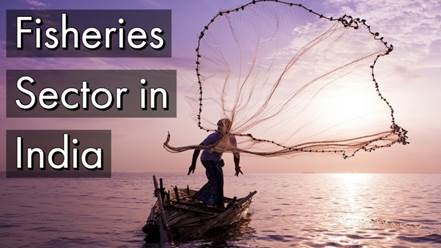
Disclaimer: Copyright infringement not intended.
Context
- Recently, National Fisheries Development Board, Union Ministry of Fisheries, Animal Husbandry and Dairying, celebrated the National Fish Farmers Day.
National Fish Farmers Day
About
- National Fish Farmers Day is celebrated on 10th July every year to demonstrate solidarity with all fisher folk, fish farmers and concerned stakeholders throughout the Country.
- It is 65th National Fish Farmers Day being celebrated across the Country.
Origin
- Every year, this annual event is celebrated to commemorate Professor Dr. Hiralal Chaudhury and his colleague Alikunhi for their contribution in achieving the successful induced breeding of major carps on 10th July, 1957 at Angul in Odisha for the first time in the country.
The technology: Induced Breeding
- Hiralal Chaudhury succeeded in induced breeding through administration of carp pituitary hormone extract in the breeding of major carps. The technology was later on standardized and fine-tuned by developing synthetic hormone for quality seed production across the country.
- This pioneering work of induced breeding over the years has transformed the growth of aquaculture sector from traditional to intensive aquaculture practices and led to success of modern aquaculture industry.
India’s Fisheries Sector
Important Stats
- Fishing Sector in India, with about 7.7% of the global fish production, is the third largest fish producing country and the second largest aquaculture fish producer in the world.
- The country is also home to more than 10% of the global fish biodiversity and is one of the 17-mega biodiversity rich countries.
- Fisheries and aquaculture witnessed manifold rise in its production during past decades, from 5 lakh tons in 1950-51 to 142 lakh tons in FY 2019-20.
- The sector provides livelihood to about 16 million fishers and fish farmers at the primary level and almost twice the number along the value chain, and has enough potential to generate income, employment, growth in subsidiary industries, and earn foreign exchange for the nation.
- The share of fisheries sector in the total GDP (at current prices) increased from 0.40% in 1950-51 to 1.07% of the total GDP in
- The sector has contributed about 1.24% to the country’s Gross Value Added (GVA) and over 7.28% to the agricultural GVA.
- Export earnings from the Fisheries sector has been Rs.46,662.85 crores during 2019-20.
- Fisheries sector has been recognized as a ‘Sunrise Sector’ and has demonstrated an outstanding double-digit average annual growth of 10.87% since 2014-15.
|
India Specific Key Facts
11.25 MMT Inland Fisheries production during FY 20-21
3.48 MMT Marine Fisheries production in FY 20-21
$1.79 mn Export of Ornamental Fisheries in FY 2020
Top exporting destination for Ornamental Fisheries: Thailand; UAE; Singapore; Hong Kong; China; Jordan; Taiwan
States with major breeding units for Ornamental Fisheries: Tamil Nadu; Maharashtra; Kerala; Rajasthan; Madhya Pradesh; Himachal Pradesh; West Bengal
1548 total fish landing centres
671 Cold Storages with 427,713.27 MT of capacity
44 Chilled Storages with 23,640.80 MT of capacity
91 Dry Fish Storages with 38,401.92 MT of capacity
Fishing Harbours Under Sagarmala - Ministry has sanctioned 17 fishing harbour projects worth INR 1740.26 Crore under Sagarmala Programme.
India’s marine product exports record an all-time high in FY 2021-22; Grow by over 30% to $7.74 bn
|
Regional Distribution of Fish
- Fish Production has remained uneven across the States depending on the available coastline, infrastructure and entrepreneurship. Southern Region accounted for almost half of the fish production, followed by Eastern Region with one fourth of the total national fish production.
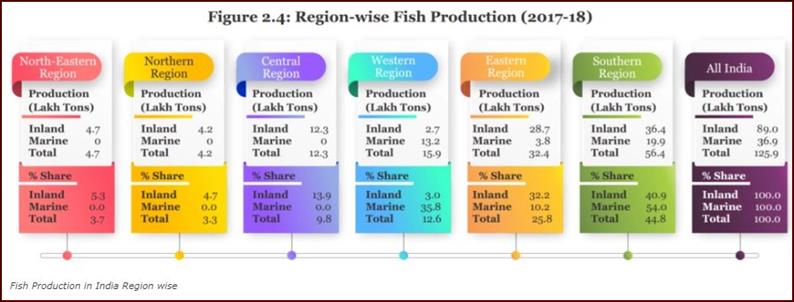
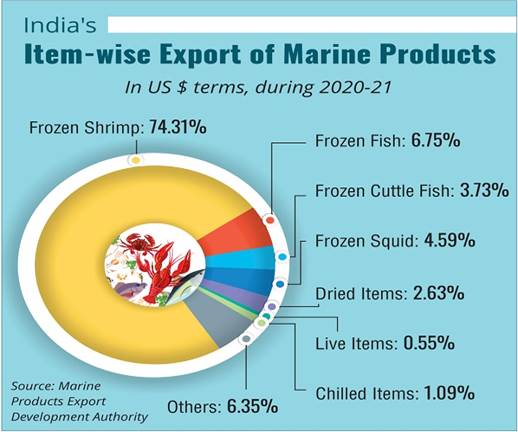
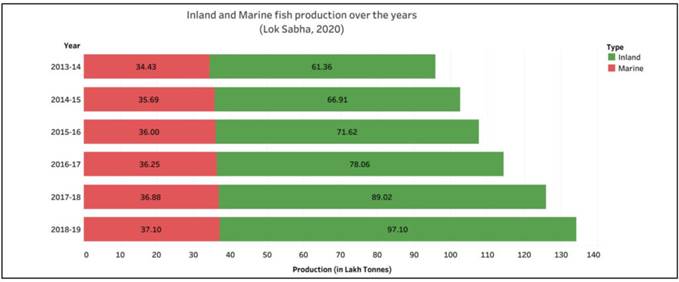
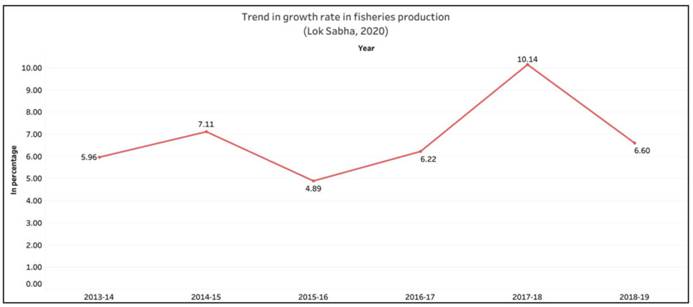
- Among the States, Andhra Pradesh (27.4%) and West Bengal (13.8%) together produce about 41% of the country’s total fish production.
- Almost every State in India produces inland fish to a certain extent whereas top six States account for about three fourth of the country’s total inland fish production.
- Andhra Pradesh, West Bengal and Uttar Pradesh together account for half of the fresh water production in the country.
- Marine fish production has remained limited to nine States and four UTs with coastlines. The West Coast produces 59% and the East Coast produces 41% of total marine fish.
- Gujarat, with 19% of the total marine fish production, is the leading marine fish producing State followed by Andhra Pradesh (16.4%) and Tamil Nadu (13.5%).
Some Schemes and Programs
Blue Revolution
- Blue Revolution, the Neel Kranti Mission has the vision to achieve economic prosperity of the country and the fishers and fish farmers as well as contribute towards food and nutritional security through full potential utilization of water resources for fisheries development in a sustainable manner, keeping in view the bio-security and environmental concerns.
- The Blue Revolution scheme has the following components:
- National Fisheries Development Board (NFDB) and its activities
- Development of Inland Fisheries and Aquaculture
- Development of Marine Fisheries, Infrastructure and Post-Harvest Operations
- Strengthening of Database & Geographical Information System of the Fisheries Sector
- Institutional Arrangement for Fisheries Sector
- Monitoring, Control and Surveillance (MCS) and other need-based Interventions
- National Scheme of Welfare of Fishermen
- Central Funding pattern: 50% of the project/unit cost for general States, leaving the rest to State agencies; 80% of the project/unit cost for North-Eastern/Hilly States leaving the rest to State agencies; 100% for Union Territories.
Deep Sea Fishing and Tuna Processing
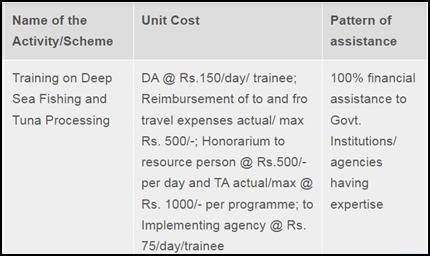
Pradhan Mantri Matsya Sampada Yojana (PMMSY)
- Approved in 2020, it is a flagship scheme for focused and sustainable development of fisheries sector in the country with an estimated investment of Rs. 20,050 crores for its implementation during a period of 5 years from FY 2020-21 to FY 2024-25 in all States/Union Territories, as a part of AatmaNirbhar Bharat Package.
- The PMMSY is an umbrella scheme with two separate Components namely (a) Central Sector Scheme (CS) and (b) Centrally Sponsored Scheme (CSS).
- The Centrally Sponsored Scheme (CSS) Component is further segregated into Non-beneficiary oriented and beneficiary orientated subcomponents/activities under the following three broad heads:
- Enhancement of Production and Productivity
- Infrastructure and Post-harvest Management
- Fisheries Management and Regulatory Framework
Under CSS
- North Eastern & Himalayan States : 90% Central share and 10% State share.
- Other States : 60% Central share and 40% State share.
- Union Territories (with legislature and without legislature): 100% Central share.
- End Implementing Agencies (EIAs)
The PMMSY would be implemented through the following agencies:
- Central Government and its entities including National Fisheries Development Board
- State/UT Governments and their entities
- State Fisheries Development Boards
- Any other End Implementing Agencies as decided by Department of Fisheries
Objectives
- PMMSY is designed to address critical gaps in fish production and productivity, quality, technology, post-harvest infrastructure and management, modernization and strengthening of value chain, traceability, establishing a robust fisheries management framework and fishers’ welfare.
- While aiming to consolidate the achievements of Blue Revolution Scheme, PMMSY envisages many new interventions such as
- fishing vessel insurance,
- support for new/up-gradation of fishing vessels/boats, Bio-toilets,
- Aquaculture in saline/alkaline areas, Sagar Mitras, FFPOs/Cs,
- Nucleus Breeding Centres,
- Fisheries and Aquaculture start-ups,
- Incubators,
- Integrated Aqua parks,
- Integrated coastal fishing villages development etc
- PMMSY scheme primarily focuses on adopting ‘Cluster or Area based approaches’ and creation of Fisheries clusters through backward and forward linkages.
- Special focus will be given for employment generation activities such as seaweed and ornamental fish cultivation.
- It emphasizes on interventions for quality brood, seed and feed, special focus on species diversification, critical infrastructure, marketing networks etc.
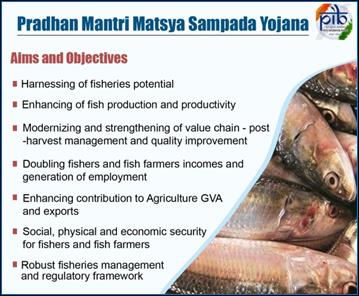
Implementation of Fisheries and Aquaculture Infrastructure Development Fund (FIDF)
- In order to address the infrastructure requirement for fisheries sector, the Department of Fisheries, Ministry of Fisheries, Animal Husbandry and Dairying during 2018-19 has created dedicated fund namely Fisheries and Aquaculture Infrastructure Development Fund (FIDF) with a total funds size of Rs 7522.48 crore.
- FIDF provides concessional finance to the Eligible Entities (EEs), including State Governments/Union Territories and State entities for development of identified fisheries infrastructure facilities through Nodal Loaning Entities (NLEs) namely
(i) National Bank for Agriculture and Rural Development (NABARD),
(ii) National Cooperatives Development Corporation (NCDC) and
(iii) All scheduled Banks.
- Under the FIDF, the Department of Fisheries provides interest subvention up to 3% per annum for providing the concessional finance by the NLEs at the interest rate not lower than 5% per annum.
- Loan lending period under FIDF is five years from 2018-19 to 2022-23 and maximum repayment period of 12 years inclusive of moratorium of 2 years on repayment of principal.
Kisan Credit Card (KCC)
- Launched in 1998, Kisan Credit Card Yojana is a scheme that offers short-term, revolving credit to farmers across India.
- The scheme was further extended for the investment credit requirement of farmers viz. allied and non-farm activities in the year 2004. These include Animal Husbandry, Dairying & Fisheries Sector.
- In this Fish Farmers receive an ATM cum credit card that can be used to withdraw cash from ATMs.
- KCC comes with a 12 monthly repayment period, which offers adequate time to pay off any debt.
Seaweed Park in Tamil Nadu
- This initiative would link and promote Seaweed farming and the seaweed-based industries together to bring out full-fledged expansion of this sector. Further, One Stop Park for entire seaweed value chain will link all the activities, farmers, processors, buyers, exporters, importers, retailers together for arriving at an optimum output and thereby maximizing value addition, minimizing wastage, increasing farmers income and creating employment opportunities.
- This will be developed on a hub and spoke model for which Government would invest about Rs 100 crores for establishing the seaweed park.
Development of 5 Major Fishing harbours as hub of economic activities
- 5 major fishing harbours – Kochi, Chennai, Visakhapatnam, Paradip, and Petuaghat – will be developed as hubs of economic activity with world class infrastructure and amenities, Seamless and quality cold chain and Hygienic handling, reduce post-harvest losses for which around 600 crores would be spent.
National Scheme of Welfare of Fishermen
- The Centrally Sponsored ‘National Scheme of Welfare of Fishermen’ envisaging to provide financial assistance to fishers for construction of house, community hall for recreation and common working place and installation of tube-wells for drinking water and assistance during lean period through saving cum relief component.
- Components of the schemes: The scheme is operated as a Centrally Sponsored Scheme through States/UT’s/FISHCOPFED (Insurance component only) and has the following three broad components:-
- Development of Model Fishermen Villages.
- Group Accident Insurance for Active Fishermen and
- Saving-cum-Relief.
Challenges facing the Fisheries Sector in India
TECHNICAL CHALLENGES
- The fishing business in the country is reliant on a few fish species – carps, pacu, and pangasius – and increasing this base will boost fish production.
- Overproduction focusing on fewer species results in an overstock of specific fish species, lowering prices and increasing volatility.
- In India, there are no additional aqua feed-consuming species or high-value fish that should be considered when introducing new species. For example, tilapia farming has yet to take off in the country.
- Inadequate hatchery technology for new species introduction, which could include freshwater, brackish, and marine species.
- Diversification of species will assist to keep costs stable while also driving up demand for formulated aquafeeds.
- Classical freshwater fish farming methods – large ponds, no water exchange, no draining, and no bottom sediment removal – are still in use, which can lead to disease-promoting conditions.
ECONOMIC CHALLENGES
- Poor quality fish delivered in poorly managed production systems has an impact on customer acceptability and preferences.
- The lack of proper cold chain and distribution systems has an impact on availability and marketing as a perishable item.
- DEEP-GREEN POND WATER: The presence of excessive algae in the water, which is the result of an oversupply of nutrients such as phosphorus, causes the water to turn a deep green colour, especially when the water is warm and the weather is calm. Fish waste is broken down into nitrate, which is food for plants and algae, by helpful bacteria in a sequence of steps, resulting in green pond water even with heavy loads. Algal blooms are defined by the World Health Organization (WHO) as a condition in which the population of algal cells surpasses 100,000 cells per ml. Blooming problems are most common during the summer months.
- RED LAYER ON POND WATER: Excess iron or EU glenoid algae in the pond water cause the red layer on the water’s surface to appear. As a result, food and oxygen are scarce in the water.
- Oxygen depletion in pond and fish gasping for air: A challenge that fish growers frequently experience. Fish usually begin floating and clutching on the water surface quite early in the morning. It occurs owing to a lack of dissolved oxygen in the water. Fish begin to die when there is a severe and long-term lack of oxygen, and dead fish have their mouths wide open. Although large fish are more likely to perish first, fish of all sizes are frequently impacted. At the pond’s edge, molluscs and crabs congregate.
OTHER FUTURE CHALLENGES
- Meeting growing demands for seed, feed and fertilizers, in terms of quantities and quality
- Increasingly severe competition with other resource (land/water/feed) users;
- Deteriorating quality of water supplies resulting from aquatic pollution;
- Climate change
- Weak marketing and extension network
- Overfishing: This term refers to the practice of catching fish faster than they are able to reproduce. It leads to removing these prey species from the marine environment impact predators and the aquatic ecosystem.
- Bycatch: Bycatch refers to the fish, seafood, turtles, seabirds and other animals that are not targeted by fisheries, but are incidentally caught by broad-sweeping fishing mechanisms like gillnets and bottom trawls.
- Damage to the ocean floor: Bottom trawls are capable of destroying anything in their paths.
- Illegal Fishing: As fish species become more depleted and demand for product rises, there have been increases in illegal fishing. This takes many forms, including: keeping undersized fish, fishing in territories without permission, catching fish off-season, failing to record catch information, and using illegal procedures.
Way Ahead
- The Fishing Sector has been instrumental in sustaining the livelihoods of over 28 million people in India especially for marginalized and vulnerable communities and has contributed towards encourage socio-economic development.
- In order to face these above challenges, the fisheries sector must develop the capacity to build and run effective quality assurance systems to comply with increasing stringent international standards of international markets as well as extending these to the domestic markets.
- Similarly, it should promote efforts to improve selective fishing gears to minimize by-catches of juveniles and non-target species and to develop technologies to make economical utilization of unavoidable by-catches.
- The implementation of the Code of Conduct for Responsible Fisheries could facilitate sustainable utilization of fishery resources and hence to overcome constraints in facing the above-mentioned challenges. In the long term, however, there is the need to develop national and regional fishery governance to ensure rational and effective fisheries management in the region.
https://www.pib.gov.in/PressReleasePage.aspx?PRID=1840610
1.png)




















